Picture this: your organization has just invested millions in AI systems, only to face a €35 million fine for non-compliance. Sound dramatic? It's becoming reality for companies navigating the complex landscape of AI governance without a clear roadmap.
With the global AI governance market projected to surge from $227.65 million in 2024 to a staggering $4.3 billion by 2033 (representing a 36.71% CAGR), the stakes have never been higher. As 78% of organizations now deploy AI systems (up from 55% in 2023), understanding the differences between the EU AI Act and ISO 42001 isn't just academic - it's business-critical.
In this comprehensive guide, you'll discover the fundamental differences between these two frameworks, understand their surprising overlap, and learn how to leverage both for maximum competitive advantage. Whether you're a Chief AI Officer, compliance manager, or technology leader, this article will equip you with actionable insights to navigate AI governance with confidence.
The Problem: Navigating Two Different AI Governance Approaches
Organizations deploying AI systems today face a bewildering choice: comply with the legally binding EU AI Act, pursue voluntary ISO 42001 certification, or somehow manage both simultaneously. The confusion is understandable - both frameworks address AI governance, risk management, and ethical considerations, yet they approach these challenges from fundamentally different angles.
The EU AI Act, which began enforcement on February 2, 2025, represents the world's first comprehensive legal framework for artificial intelligence. Meanwhile, ISO/IEC 42001, published in 2023, offers the first international standard for AI management systems. Both promise to guide organizations toward responsible AI, but their mechanisms, obligations, and outcomes differ significantly.
This complexity creates real business risks. Companies operating in the EU must comply with the AI Act or face severe penalties, but many also recognize the value of ISO 42001 certification for demonstrating responsible AI practices globally. The question isn't whether to engage with AI governance - it's understanding which framework serves your specific needs and how they work together.
Understanding the EU AI Act: Legal Framework for AI Safety
The European Union's Artificial Intelligence Act represents a paradigm shift in technology regulation. Unlike traditional standards, this is binding legislation that applies across all EU member states, with extraterritorial reach affecting any organization deploying AI systems in the European market.
Core Architecture of the EU AI Act
At its heart, the EU AI Act employs a risk-based classification system that categorizes AI systems into four distinct tiers: unacceptable risk (prohibited), high risk, limited risk, and minimal risk. This tiered approach ensures that regulatory burden aligns proportionally with potential harm.

Prohibited AI practices include systems that manipulate human behavior to circumvent free will, enable social scoring by governments, or conduct real-time biometric identification in public spaces (with narrow exceptions for law enforcement). These prohibitions became enforceable on February 2, 2025, and violations can trigger fines up to €35 million or 7% of global annual turnover (whichever is higher).
High-risk AI systems - those used in employment, education, law enforcement, critical infrastructure, or as safety components in regulated products - face stringent requirements including conformity assessments, technical documentation, risk management systems, and ongoing monitoring obligations. These comprehensive requirements become fully applicable on August 2, 2026.
Implementation Timeline and Obligations
The EU AI Act follows a phased implementation approach designed to give organizations time to adapt:
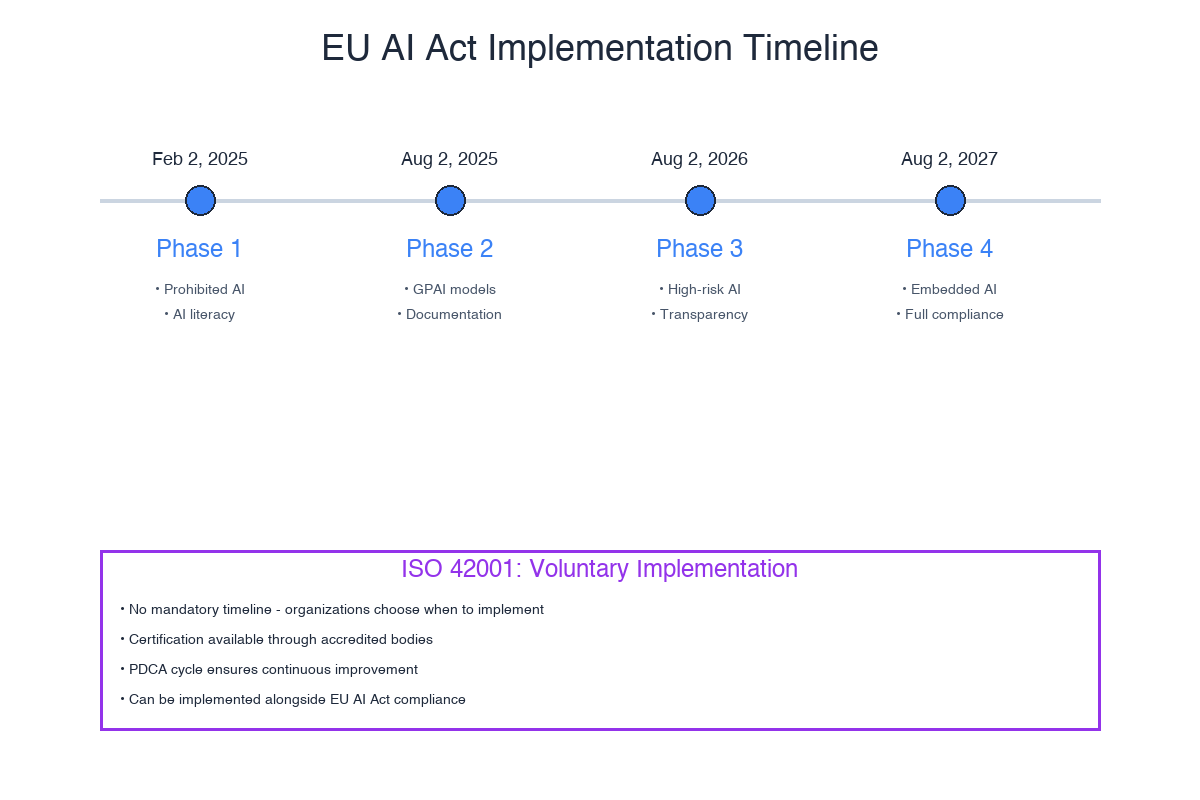
Phase 1 (February 2, 2025): Prohibited AI practices and AI literacy requirements are now in effect. Organizations must ensure appropriate AI literacy among staff who develop, deploy, or use AI systems.
Phase 2 (August 2, 2025): General-Purpose AI (GPAI) model providers must now maintain technical documentation, publish training data summaries, and comply with EU copyright law.
Phase 3 (August 2, 2026): High-risk AI obligations become fully applicable, including conformity assessments, CE marking requirements, and comprehensive transparency obligations.
Phase 4 (August 2, 2027): Extended deadline for high-risk AI systems embedded into regulated products.
The Act's enforcement mechanism relies on market surveillance authorities in each member state, coordinated by the European AI Office. For more details, see our guide on understanding the EU AI Act implications and compliance.
Understanding ISO 42001: Voluntary AI Management Standard
While the EU AI Act wields regulatory teeth, ISO/IEC 42001 takes a fundamentally different approach. Published in December 2023, it represents the world's first international standard specifically designed for artificial intelligence management systems (AIMS).
The AIMS Framework Philosophy
ISO 42001 follows the established ISO management system structure, making it familiar to organizations already certified in ISO 9001 (quality), ISO 27001 (information security), or ISO 14001 (environmental management). The standard employs the Plan-Do-Check-Act (PDCA) cycle, a continuous improvement methodology that ensures AI governance evolves alongside technology and business needs.
ISO 42001 structures its requirements across ten clauses covering organizational context, leadership, planning, support, operation, performance evaluation, and improvement. The standard's Annex A contains 39 specific AI controls addressing data governance, AI system transparency, human oversight, and accountability structures.
Unlike the EU AI Act's prescriptive requirements, ISO 42001 allows organizations to tailor controls to their specific context, risk profile, and AI applications. Certification comes through third-party audits by accredited certification bodies, providing external validation of an organization's AI governance maturity. However, certification remains voluntary - there are no legal penalties for non-compliance, though market pressures increasingly favor certified organizations.
The 40-50% Overlap: Where the Frameworks Align
Despite their different approaches, the EU AI Act and ISO 42001 share substantial common ground. Research suggests approximately 40-50% overlap in high-level requirements, particularly around risk management, data governance, transparency, and ethical considerations.
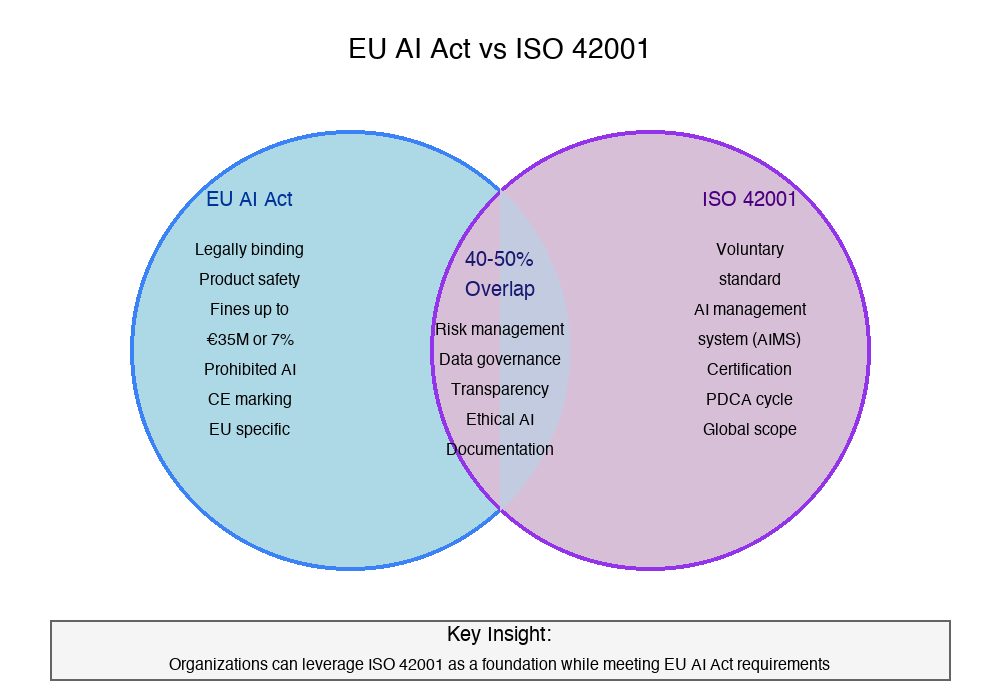
Both frameworks emphasize risk-based approaches to AI governance. The EU AI Act's four-tier risk classification parallels ISO 42001's requirement to identify, assess, and treat AI-specific risks according to their severity and likelihood. This convergence means that risk management frameworks developed for ISO 42001 certification can substantially support EU AI Act compliance.
Article 10 of the EU AI Act prescribes detailed data governance requirements for high-risk AI systems, including data set categorization, examination for bias, and assessment of appropriateness. ISO 42001 addresses similar themes through its data management controls, emphasizing data quality, representativeness, and bias mitigation.
Both frameworks demand substantial documentation, though with different emphases. Technical descriptions prepared for ISO 42001 audits can be adapted to meet EU AI Act documentation requirements, reducing administrative burden.
Perhaps most significantly, both frameworks embed ethical considerations into AI governance. The EU AI Act's fundamental rights impact assessments for high-risk systems parallel ISO 42001's requirement to consider ethical implications including fairness, non-discrimination, and human dignity.
For organizations serious about AI governance frameworks and best practices, recognizing these overlaps enables efficient resource allocation. Rather than treating the EU AI Act and ISO 42001 as separate compliance exercises, smart organizations build integrated governance programs leveraging synergies between frameworks.
Critical Differences: What Sets Them Apart
While overlaps create opportunities for efficiency, understanding the critical differences between the EU AI Act and ISO 42001 remains essential for effective AI governance strategy.
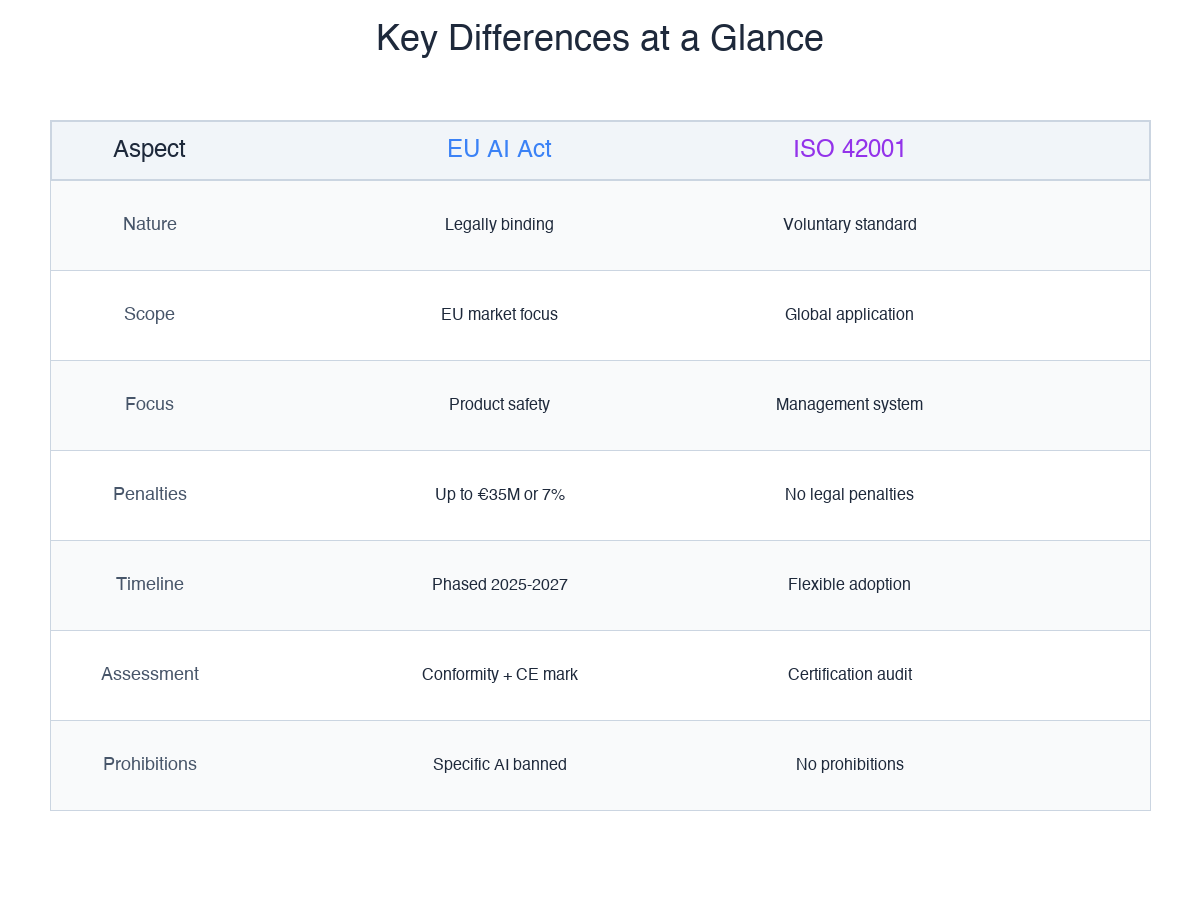
Legal Force vs. Voluntary Adoption
The most fundamental difference lies in enforceability. The EU AI Act is binding legislation with significant enforcement mechanisms, while ISO 42001 remains a voluntary standard organizations adopt by choice.
Non-compliance with the EU AI Act carries severe consequences: fines up to €35 million or 7% of global annual turnover for prohibited AI practices, €15 million or 3% for other infringements, and €7.5 million or 1.5% for providing incorrect information. These penalties apply regardless of organizational size or intent.
Conversely, ISO 42001 certification occurs through consensual third-party audits. Organizations failing certification face no legal penalties - only the reputational and competitive consequences of not demonstrating AI governance maturity.
Geographic Scope and Product Focus
The EU AI Act applies specifically to AI systems placed on the EU market or whose outputs are used in the EU, regardless of where the provider is established. This extraterritorial reach affects global organizations deploying AI systems accessible to European users.
ISO 42001, as an international standard, applies globally without geographic restrictions, making it attractive for multinational companies seeking unified AI governance frameworks across jurisdictions.
The EU AI Act fundamentally focuses on product safety, treating AI systems as products that must meet safety requirements before market placement. ISO 42001 centers on organizational management systems, focusing on how organizations govern AI throughout development, deployment, and ongoing operation.
Specificity and Prohibitions
The EU AI Act often prescribes specific, detailed requirements. For example, it mandates that logs be kept for at least six months, prescribes specific content for technical documentation, and requires particular conformity assessment procedures.
ISO 42001 provides principle-based guidance, allowing organizations to tailor implementations to their specific contexts. While it requires log retention, it doesn't prescribe specific durations.
Perhaps most significantly, the EU AI Act explicitly prohibits certain AI applications deemed to present unacceptable risks, including social scoring systems, manipulative AI, and most real-time biometric identification in public spaces. ISO 42001 does not prohibit any AI practices - instead, it requires organizations to determine whether prohibitions exist under applicable laws and regulations.
Creating a Comprehensive AI Governance Strategy
Ready to Take Control of Your AI Governance?
VerifyWise helps organizations navigate both EU AI Act compliance and ISO 42001 certification with an integrated governance platform designed for modern AI systems.
Start Governing Your AI Systems →
Join leading organizations building trust through comprehensive AI governance
Given the complexity of navigating both frameworks, organizations need strategic approaches that maximize efficiency while ensuring comprehensive coverage.
The Integrated Governance Model
Rather than treating the EU AI Act and ISO 42001 as separate compliance exercises, leading organizations implement integrated governance models that leverage synergies while addressing unique requirements of each framework.

This approach involves several key steps:
Step 1: Comprehensive AI Inventory - Begin by cataloging all AI systems your organization develops, deploys, or uses. This inventory serves both frameworks.
Step 2: Dual Risk Assessment - Conduct risk assessments satisfying both frameworks simultaneously. Classify systems according to EU AI Act categories while also performing ISO 42001's broader risk analysis.
Step 3: Unified Documentation Systems - Develop documentation templates capturing information required by both frameworks, dramatically reducing administrative burden.
Step 4: Integrated Controls Implementation - Implement controls satisfying overlapping requirements first, then layer framework-specific requirements.
Step 5: Coordinated Auditing - Schedule assessments strategically, allowing preparation for one to strengthen readiness for the other.
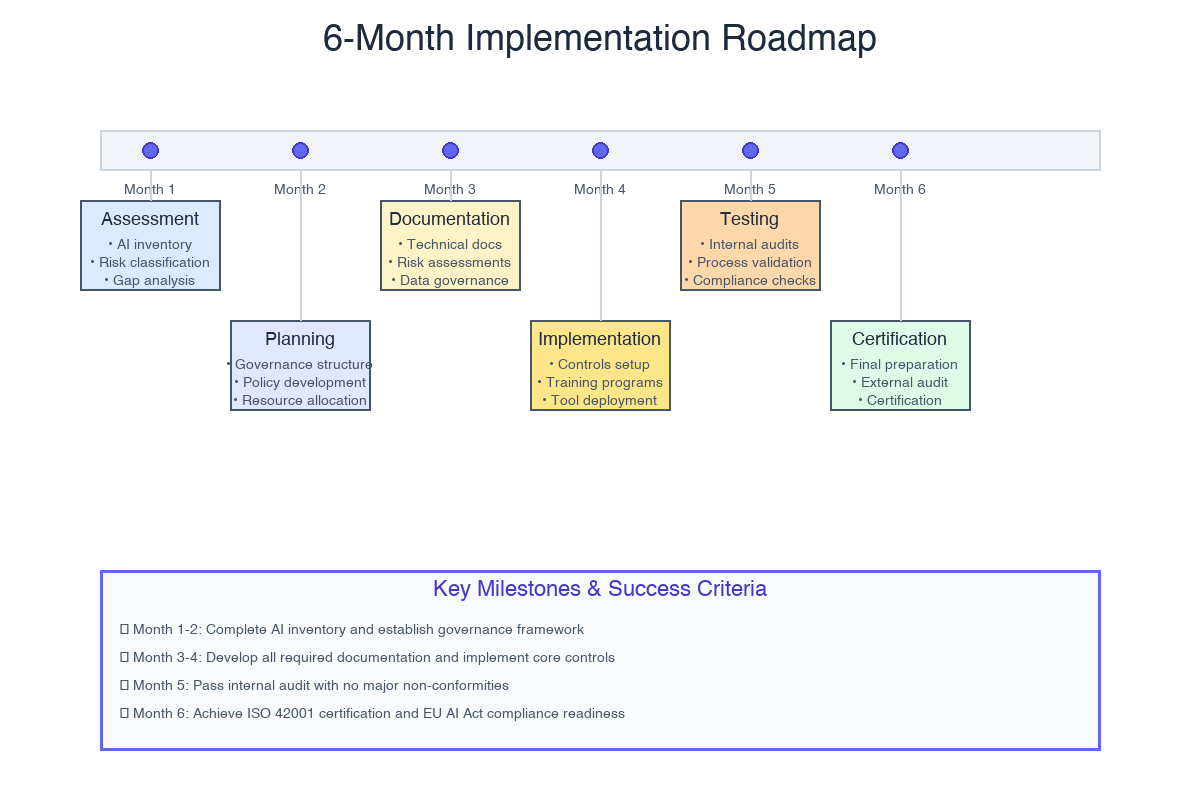
Organizational Structure for Dual Compliance
Effective governance requires appropriate organizational structures. Leading organizations establish Chief AI Officer roles with authority spanning both frameworks, supported by cross-functional governance committees including legal, technical, ethics, and business representatives.
Technology platforms supporting AI governance should accommodate both frameworks. VerifyWise's platform specifically addresses this integrated approach, enabling organizations to manage EU AI Act compliance and ISO 42001 certification through a single interface.
When to Prioritize One Framework Over the Other
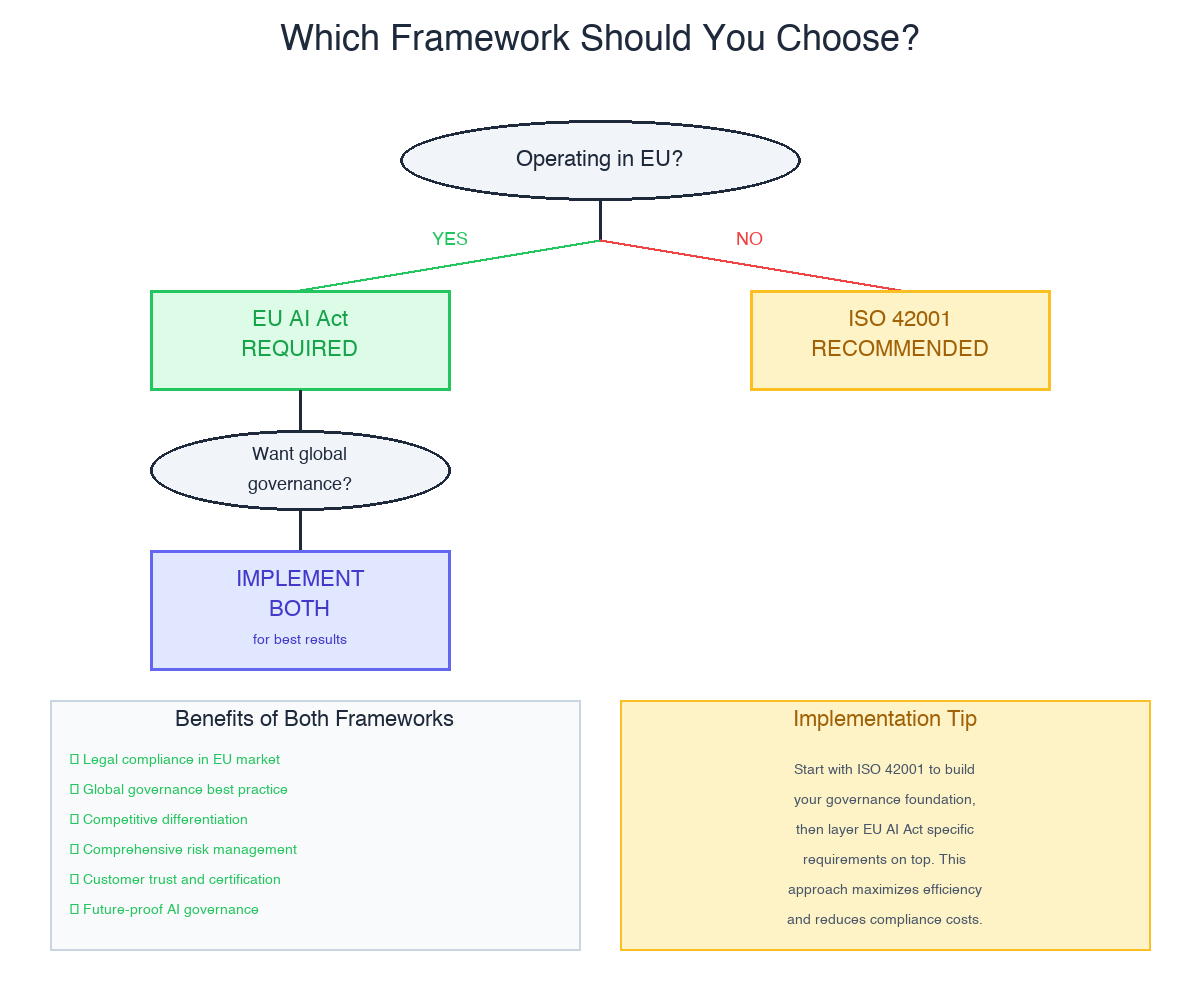
Prioritize EU AI Act when:
- Operating primarily in the European market
- Developing high-risk AI systems subject to EU AI Act requirements
- Facing imminent compliance deadlines
- Regulatory penalties pose significant business risks
Prioritize ISO 42001 when:
- Operating globally across multiple jurisdictions
- Building organizational AI governance capabilities
- Seeking competitive differentiation
- Customers require demonstration of AI governance maturity
Best Practices and Common Pitfalls
Organizations implementing AI governance can learn from early adopters' successes and mistakes.
Best Practices
Start early and plan strategically. AI governance implementation takes longer than most organizations expect. Beginning well before compliance deadlines allows thoughtful implementation rather than rushed, costly fixes.
Invest in staff training and AI literacy. Both frameworks require organizational understanding of AI governance. Comprehensive training programs yield returns far exceeding their costs.
Leverage existing management systems. Organizations already certified in ISO 27001 or ISO 9001 can build on these foundations for ISO 42001.
Document everything systematically. Both frameworks demand extensive documentation. Establishing systematic practices from the start prevents scrambling during audits.
Common Pitfalls to Avoid
Treating ISO 42001 certification as EU AI Act compliance. While overlap exists, ISO 42001 certification alone doesn't ensure EU AI Act compliance.
Underestimating technical documentation requirements. Starting documentation efforts late in development creates significant retrofitting challenges.
Neglecting third-party AI systems. Organizations deploying third-party AI systems remain subject to obligations under both frameworks.
Overlooking continuous monitoring obligations. Both frameworks emphasize ongoing monitoring rather than one-time assessments.
The Future of AI Governance
AI governance continues evolving rapidly. While the EU AI Act currently stands alone as comprehensive AI legislation, other jurisdictions are developing similar frameworks. Brazil, Canada, South Korea, and Singapore have proposed AI regulations showing significant EU AI Act influence.
This convergence suggests ISO 42001 may become increasingly valuable as a global governance baseline upon which jurisdiction-specific requirements layer. Organizations with strong ISO 42001 foundations will likely find adapting to emerging regulations easier.
The AI governance profession itself is maturing rapidly. According to the IAPP's 2025 AI Governance Profession Report, dedicated AI governance roles increased 156% year-over-year, with Chief AI Officer positions becoming commonplace in large organizations.
Conclusion: Charting Your AI Governance Path Forward
The AI governance landscape presents both challenges and opportunities. The EU AI Act's binding requirements create compliance imperatives for organizations operating in Europe, while ISO 42001 offers globally applicable frameworks for demonstrating AI governance maturity.
Understanding that these frameworks serve complementary purposes - one ensuring legal compliance with product safety requirements, the other building organizational management capabilities - enables strategic approaches maximizing value while managing compliance costs. The 40-50% overlap in requirements creates efficiencies for organizations willing to invest in integrated governance approaches.
Your organization's optimal path depends on specific circumstances: market focus, AI application types, risk tolerance, competitive positioning, and existing governance maturity.
Key Takeaways
-
The EU AI Act and ISO 42001 serve different purposes: One is binding legislation focused on product safety; the other is a voluntary standard focused on management systems.
-
Significant overlap exists but doesn't eliminate unique requirements: While 40-50% overlap creates efficiencies, organizations cannot rely on one framework to satisfy the other completely.
-
Integrated approaches maximize efficiency: Organizations treating these as separate compliance exercises miss significant synergies.
-
ISO 42001 can provide foundations for EU AI Act compliance: Organizations implementing ISO 42001 first often find EU AI Act compliance easier.
-
Documentation and systematic processes pay dividends: Both frameworks demand substantial documentation and systematic approaches.
-
AI governance is continuous, not one-time: Neither framework treats compliance as a checkpoint to pass.
Next Steps
If you're ready to build comprehensive AI governance addressing both the EU AI Act and ISO 42001:
- Conduct an AI system inventory documenting all AI systems your organization develops, deploys, or uses
- Perform dual risk assessments classifying systems under both frameworks
- Identify gaps between current practices and requirements
- Develop an integrated implementation roadmap sequencing initiatives for maximum efficiency
- Invest in AI governance capabilities including dedicated roles, training programs, and technology platforms
For organizations seeking expert guidance navigating these complex frameworks, specialized AI governance platforms like VerifyWise provide integrated solutions supporting both EU AI Act compliance and ISO 42001 certification through unified interfaces, reducing complexity while ensuring comprehensive coverage.
The path to effective AI governance isn't always straightforward, but with clear understanding of the landscape, strategic approaches, and appropriate support, organizations can build AI governance as a competitive advantage rather than merely a compliance obligation.
Additional Resources
- AI Governance Frameworks and Best Practices
- Global Approaches to AI Governance: A Comparison
- What is a Chief AI Officer?
- Dedicated AI Governance vs In-House Solutions
- EU Releases Pivotal Guidelines for General Purpose AI Models
This article was last updated on November 5, 2025. AI regulations and standards continue to evolve. Always consult with legal and compliance professionals for guidance specific to your organization's circumstances.